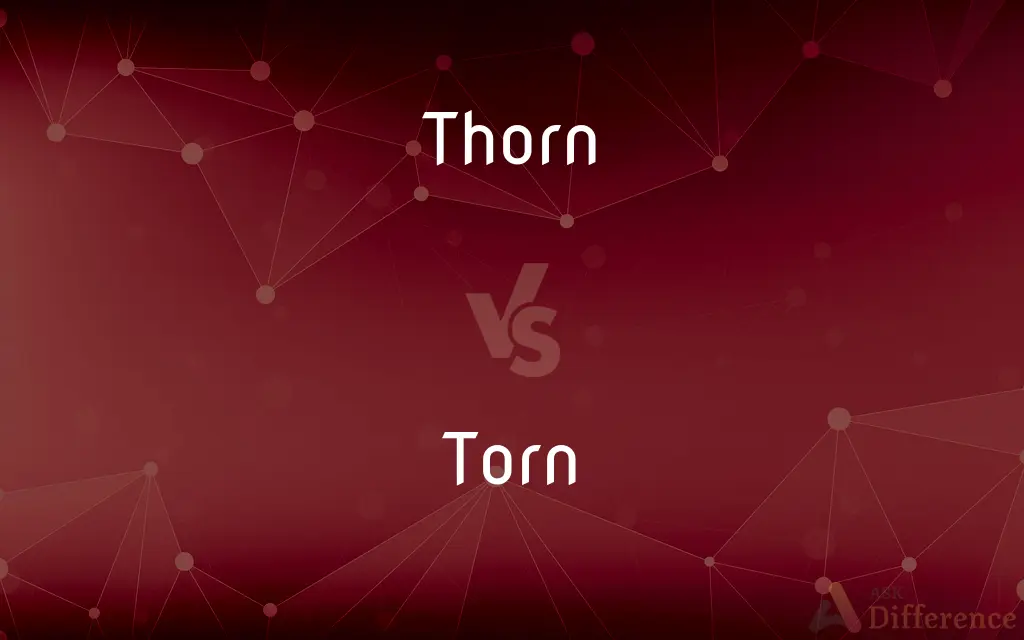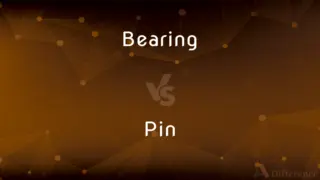Thorn vs. Torn — What's the Difference?
By Urooj Arif & Fiza Rafique — Updated on March 19, 2024
A thorn is a sharp plant growth, protecting it from herbivores, whereas torn refers to something that is ripped or damaged through force.

Difference Between Thorn and Torn
Table of Contents
ADVERTISEMENT
Key Differences
Thorns are specialized structures found on plants, serving as a defense mechanism against herbivores and deterring unwanted contact. They are often sharp, rigid, and may be part of the stem or leaf. On the other hand, "torn" is a condition or state describing materials or objects that have been damaged by being pulled apart or ripped. This term is commonly used to describe fabric, paper, or other materials that have been physically divided into parts through force, suggesting damage or imperfection.
While thorns are naturally occurring parts of certain plants, grown as an evolutionary adaptation for protection, torn results from an external action exerted on an object or material, leading to its physical alteration. Thorns remain attached to their parent plant, contributing to the plant's survival by warding off animals and sometimes humans. Conversely, torn materials often require repair or replacement, as the act of tearing usually signifies accidental damage or wear and tear.
Thorns can vary greatly in size, shape, and location depending on the plant species, and they play a crucial role in the ecological balance by influencing the behavior of herbivores and predators. Whereas, the condition of being torn is not specific to any material or object and can occur in a wide range of contexts, from clothing and documents to emotional or relational metaphorical uses, indicating the breadth of its application in language.
In botanical terminology, thorns are distinct from spines and prickles, with each type of sharp plant growth having specific structural differences and origins. This precise terminology contrasts with the more general usage of "torn," which does not distinguish between types or causes of tears, applying universally to any instance where material integrity is compromised.
The presence of thorns on a plant often has additional benefits, such as reducing transpiration by providing shade or trapping moisture, showing how natural adaptations serve multiple functions. In contrast, torn objects may lose functionality or value, highlighting a contrast between the protective benefits of thorns and the detrimental effects of being torn.
ADVERTISEMENT
Comparison Chart
Definition
A sharp, protective growth on certain plants.
Refers to something that has been ripped or damaged.
Origin
Naturally occurring as part of a plant's defense mechanism.
Result of external force causing damage.
Functionality
Protects plants from herbivores and deter unwanted contact.
Indicates damage and may impair functionality.
Occurrence
Specific to certain plants.
Can happen to a wide range of materials and objects.
Structural Integrity
Integral part of the plant, enhancing survival.
Compromised, often requiring repair or replacement.
Compare with Definitions
Thorn
A defense mechanism in plants.
Thorns protect cacti from animals.
Torn
Can apply to emotional states metaphorically.
She felt torn between two decisions.
Thorn
Part of the plant's stem or leaf.
The acacia tree has long thorns on its branches.
Torn
Damaged by being pulled apart or ripped.
His shirt was torn in the altercation.
Thorn
Found on various plants.
Thorns are common in the rose family.
Torn
Indicates a state of damage.
The flag was old and torn after years of display.
Thorn
Can vary in size and shape.
The thorns of the hawthorn are short and stout.
Torn
Loss of integrity or function.
The torn document needed to be restored.
Thorn
A sharp, pointed outgrowth on a plant.
The rose bush's thorns pricked her finger.
Torn
Referring to material that has been split.
The torn page was difficult to read.
Thorn
A modified branch in the form of a sharp woody structure.
Torn
Past participle of tear1.
Thorn
Any of various other sharp protuberances, such as a spine.
Torn
Past participle of tear(rip, rend, speed).
Thorn
Any of various shrubs, trees, or woody plants bearing such sharp structures.
Torn
Having edges that are jagged from injury
Thorn
Any of various sharp protuberances on an animal.
Torn
Disrupted by the pull of contrary forces;
Torn between love and hate
Torn by conflicting loyalties
Torn by religious dissensions
Thorn
One that causes sharp pain, irritation, or discomfort
He is a thorn in my side.
Thorn
The runic letter þ, used in Old English, Middle English, and Old Norse manuscripts to represent both the voiceless sound (th) of Modern English thin and the voiced sound (th) of Modern English this, and in modern Icelandic orthography to represent the voiceless sound (th).
Thorn
(botany) A sharp protective spine of a plant.
Thorn
Any shrub or small tree that bears thorns, especially a hawthorn.
The white thorn
The cockspur thorn
Thorn
(figurative) That which pricks or annoys; anything troublesome.
Thorn
A letter of Latin script (capital: Þ, small: þ), borrowed from the futhark; today used only in Icelandic to represent the voiceless dental fricative, but originally used in several early Germanic scripts, including Old English where it represented the dental fricatives that are today written th (Old English did not have phonemic voicing distinctions for fricatives).
Thorn
To pierce with, or as if with, a thorn (sharp pointed object).
Thorn
A hard and sharp-pointed projection from a woody stem; usually, a branch so transformed; a spine.
Thorn
Any shrub or small tree which bears thorns; especially, any species of the genus Cratægus, as the hawthorn, whitethorn, cockspur thorn.
Thorn
Fig.: That which pricks or annoys as a thorn; anything troublesome; trouble; care.
There was given to me a thorn in the flesh, the messenger of Satan to buffet me.
The guilt of empire, all its thorns and cares,Be only mine.
Thorn
The name of the Anglo-Saxon letter , capital form . It was used to represent both of the sounds of English th, as in thin, then. So called because it was the initial letter of thorn, a spine.
Thorn
To prick, as with a thorn.
I am the only rose of all the stockThat never thorn'd him.
Thorn
Something that causes irritation and annoyance;
He's a thorn in my flesh
Thorn
A sharp-pointed tip on a stem or leaf
Thorn
A Germanic character of runic origin
Common Curiosities
What does it mean if something is torn?
It means the item has been damaged by ripping or pulling apart.
Can thorns be found on all plants?
No, thorns are specific to certain plant species.
Are thorns always harmful?
While thorns can cause injury, their primary function is to protect the plant.
Is tearing always accidental?
Tearing can be both accidental and intentional, depending on the context.
How do objects become torn?
Objects become torn through external force or wear and tear.
Do all plants with thorns have flowers?
Many, but not all, plants with thorns also have flowers.
Can the presence of thorns deter all animals?
While effective against many herbivores, some animals have adapted to handle thorns.
What are thorns?
Thorns are sharp, protective outgrowths on certain plants.
Do thorns serve any purpose beyond protection?
Yes, thorns can also reduce transpiration and trap moisture.
Can torn materials be repaired?
Yes, depending on the extent of the damage, torn materials can often be repaired.
What types of materials can be torn?
Fabrics, paper, and other flexible materials are most susceptible to tearing.
How do you repair a torn object?
Repair methods vary, including sewing for fabric or taping for paper.
Are thorns considered a type of spine?
No, thorns, spines, and prickles are different types of plant growths.
Is being torn always a sign of physical damage?
Primarily, yes, but "torn" can also describe emotional or metaphorical states.
What are the benefits of having thorns on a plant?
Thorns provide protection from herbivores, reduce transpiration, and may trap moisture.
Share Your Discovery

Previous Comparison
Bearing vs. Pin
Next Comparison
Slime vs. GelAuthor Spotlight
Written by
Urooj ArifUrooj is a skilled content writer at Ask Difference, known for her exceptional ability to simplify complex topics into engaging and informative content. With a passion for research and a flair for clear, concise writing, she consistently delivers articles that resonate with our diverse audience.
Co-written by
Fiza RafiqueFiza Rafique is a skilled content writer at AskDifference.com, where she meticulously refines and enhances written pieces. Drawing from her vast editorial expertise, Fiza ensures clarity, accuracy, and precision in every article. Passionate about language, she continually seeks to elevate the quality of content for readers worldwide.















































